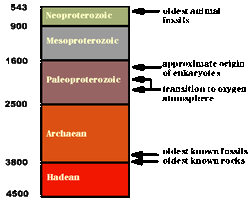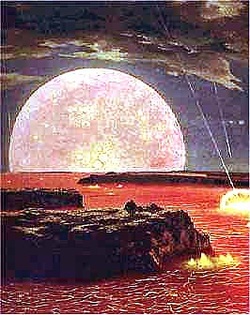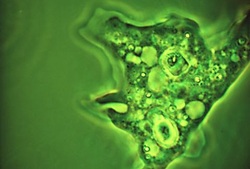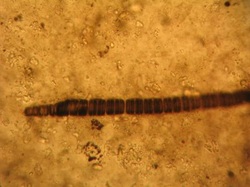Pre- Cambrian Era

It is not known when life originated, but carbon in 3.8 billion year old rocks from islands off western Greenland may be of organic origin. Well-preservedbacteria older than 3.46 billion years have been found in Western Australia. Probable fossils 100 million years older have been found in the same area. There is a fairly solid record of bacterial life throughout the remainder of the Precambrian.
Excepting a few contested reports of much older forms from USA and India, the first complex multicelled life forms seem to have appeared roughly 600 Ma. A quite diverse collection of soft-bodied forms is known from a variety of locations worldwide between 542 and 600 Ma. These are referred to as Ediacaran or Vendian biota. Hard-shelled creatures appeared toward the end of that timespan.
A very diverse collection of forms appeared around 544 Ma, starting in the latest Precambrian with a poorly understood small shelly fauna and ending in the very early Cambrian with a very diverse, and quite modern Burgess fauna, the rapid radiation of forms called the Cambrian explosion of life.
The Precambrian is sometimes referred to as an "eon." However, it actually has no rank. It is simply Precambrian time. The Precambrian is that stretch of geological time from the formation of the Earth itself to the start of the Cambrian period. This immensely long stretch of time - some four billion years or more - saw the formation of the Earth as a planetary body, including geosphere, atmosphere, and hydrosphere, as well as the appearance of the biosphere and hence the transformation of the Earth from a dead planet to a living one.The Precambrian Supereon is divided into three Precambrian eons: the Hadean (4500-3950 Ma), Archean (3950-2500 Ma), and Proterozoic (2500-542 Ma)
Excepting a few contested reports of much older forms from USA and India, the first complex multicelled life forms seem to have appeared roughly 600 Ma. A quite diverse collection of soft-bodied forms is known from a variety of locations worldwide between 542 and 600 Ma. These are referred to as Ediacaran or Vendian biota. Hard-shelled creatures appeared toward the end of that timespan.
A very diverse collection of forms appeared around 544 Ma, starting in the latest Precambrian with a poorly understood small shelly fauna and ending in the very early Cambrian with a very diverse, and quite modern Burgess fauna, the rapid radiation of forms called the Cambrian explosion of life.
The Precambrian is sometimes referred to as an "eon." However, it actually has no rank. It is simply Precambrian time. The Precambrian is that stretch of geological time from the formation of the Earth itself to the start of the Cambrian period. This immensely long stretch of time - some four billion years or more - saw the formation of the Earth as a planetary body, including geosphere, atmosphere, and hydrosphere, as well as the appearance of the biosphere and hence the transformation of the Earth from a dead planet to a living one.The Precambrian Supereon is divided into three Precambrian eons: the Hadean (4500-3950 Ma), Archean (3950-2500 Ma), and Proterozoic (2500-542 Ma)
The Hadean Eon

The Hadean or Pregeologic Eon is the time period during which the Earth was transformed from a gaseous cloud into a solid body. The process of solidification is poorly known, however, and the Hadean may have lasted as long as one billion years.
This is the period during which the Earth's crust was formed. This crust melted and reformed numerous times, because it was continuously broken up by gigantic magma currents that erupted from the depths of the planet, tore the thin crust, and then cooled off on the surface before sinking again into the heart of the Earth.
At the same time, another important series of events began to unfold that led to the formation of sedimentary rocks through the processes of erosion, drift, and accumulation. These processes began to occur as soon as the surface cooled enough to allow the water cycle to establish itself In fact, the primitive Earth long remained covered in darkness, wrapped in dense burning clouds into which continuously poured water vapor from volcanic emissions.
This is the period during which the Earth's crust was formed. This crust melted and reformed numerous times, because it was continuously broken up by gigantic magma currents that erupted from the depths of the planet, tore the thin crust, and then cooled off on the surface before sinking again into the heart of the Earth.
At the same time, another important series of events began to unfold that led to the formation of sedimentary rocks through the processes of erosion, drift, and accumulation. These processes began to occur as soon as the surface cooled enough to allow the water cycle to establish itself In fact, the primitive Earth long remained covered in darkness, wrapped in dense burning clouds into which continuously poured water vapor from volcanic emissions.
The Archean Eon

Fossils of cyanobacterial mats (stromatolites, which were instrumental in creating the free oxygen in the atmosphere) are found throughout the Archean, becoming especially common late in the eon, while a few probable bacterial fossils are known from chert beds. In addition to the domain Bacteria (once known as Eubacteria), microfossils of the domain Archaeahave also been identified.
Life was probably present throughout the Archean, but may have been limited to simple non-nucleated single-celled organisms, called Prokaryota (formerly known as Monera). There are no knowneukaryotic fossils, though they might have evolved during the Archean without leaving any fossils. No fossil evidence yet exists for ultramicroscopic intracellular replicators such as viruses.
Life was probably present throughout the Archean, but may have been limited to simple non-nucleated single-celled organisms, called Prokaryota (formerly known as Monera). There are no knowneukaryotic fossils, though they might have evolved during the Archean without leaving any fossils. No fossil evidence yet exists for ultramicroscopic intracellular replicators such as viruses.
The Prtoerozoic Eon

The geologic record of the Proterozoic is much better than that for the preceding Archean. In contrast to the deep-water deposits of the Archean, the Proterozoic features many strata that were laid down in extensive shallow epicontinental seas; furthermore, many of these rocks are less metamorphosed than Archean-age ones, and plenty are unaltered.[1] Study of these rocks shows that the eon featured massive, rapid continental accretion (unique to the Proterozoic),supercontinent cycles, and wholly- modern orogenic activity.
The first known glaciations occurred during the Proterozoic; one began shortly after the beginning of the eon, while there were at least four during the Neoproterozoic, climaxing with the Snowball Earth of the Varangian glaciation.
One of the most important events of the Proterozoic was the gathering up of oxygen in the Earth's atmosphere. The first advanced single-celled, eukaryotes and multi-cellular life, Francevillian Group Fossils, roughly coincides with the start of the accumulation of free oxygen. This may have been due to an increase in the oxidized nitrates that eukaryotes use, as opposed to cyanobacteria. It was also during the Proterozoic that the first symbiotic relationships between mitochondria (for nearly all eukaryotes) and chloroplasts (for plants and some protists only) and their hosts evolved.The blossoming of eukaryotes such as acritarchs did not preclude the expansion of cyanobacteria; in fact, stromatolites reached their greatest abundance and diversity during the Proterozoic, peaking roughly 1.2 billion years ago.
Classically, the boundary between the Proterozoic and the Phanerozoic eons was set at the base of the Cambrian period when the first fossils of animals including trilobites and archeocyathidsappeared. In the second half of the 20th century, a number of fossil forms have been found in Proterozoic rocks, but the upper boundary of the Proterozoic has remained fixed at the base of theCambrian, which is currently placed at 542 Ma.-From Wikipedia Online
The first known glaciations occurred during the Proterozoic; one began shortly after the beginning of the eon, while there were at least four during the Neoproterozoic, climaxing with the Snowball Earth of the Varangian glaciation.
One of the most important events of the Proterozoic was the gathering up of oxygen in the Earth's atmosphere. The first advanced single-celled, eukaryotes and multi-cellular life, Francevillian Group Fossils, roughly coincides with the start of the accumulation of free oxygen. This may have been due to an increase in the oxidized nitrates that eukaryotes use, as opposed to cyanobacteria. It was also during the Proterozoic that the first symbiotic relationships between mitochondria (for nearly all eukaryotes) and chloroplasts (for plants and some protists only) and their hosts evolved.The blossoming of eukaryotes such as acritarchs did not preclude the expansion of cyanobacteria; in fact, stromatolites reached their greatest abundance and diversity during the Proterozoic, peaking roughly 1.2 billion years ago.
Classically, the boundary between the Proterozoic and the Phanerozoic eons was set at the base of the Cambrian period when the first fossils of animals including trilobites and archeocyathidsappeared. In the second half of the 20th century, a number of fossil forms have been found in Proterozoic rocks, but the upper boundary of the Proterozoic has remained fixed at the base of theCambrian, which is currently placed at 542 Ma.-From Wikipedia Online
